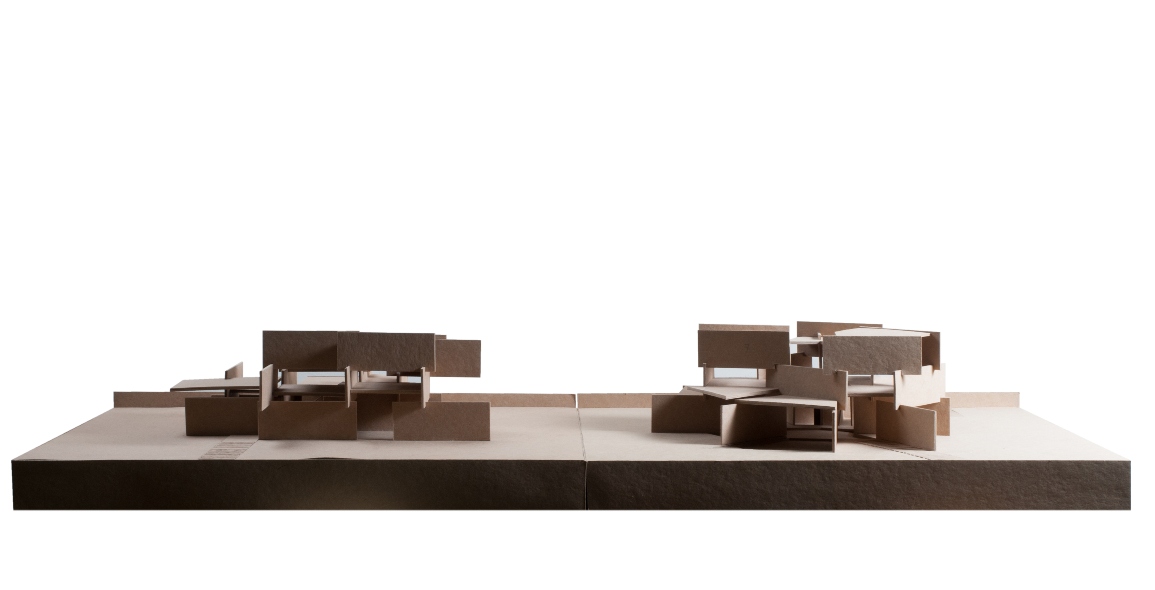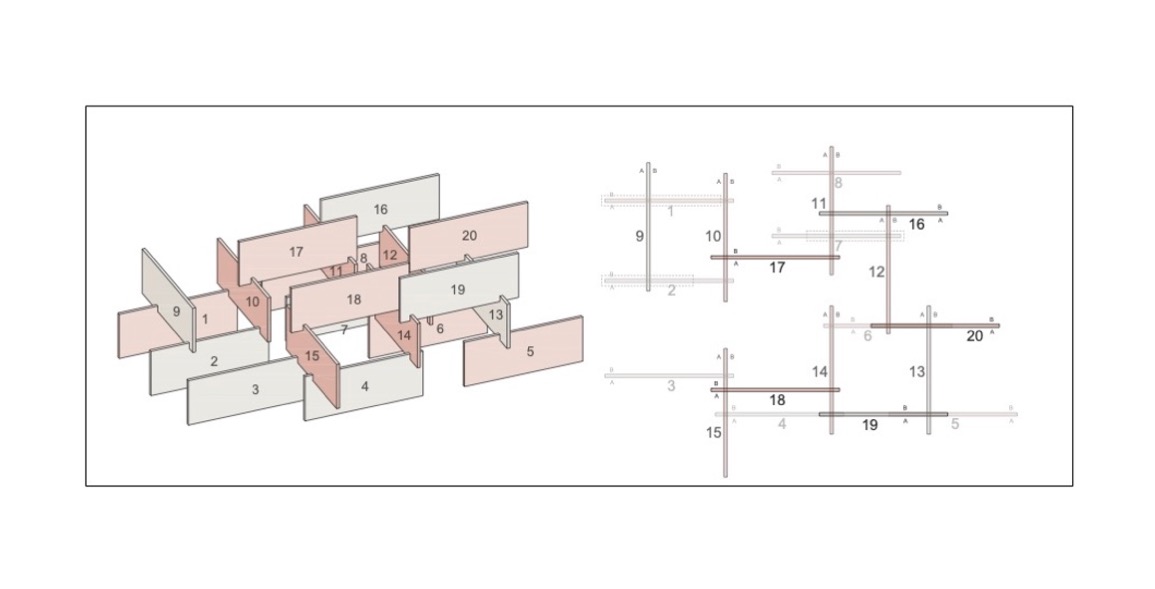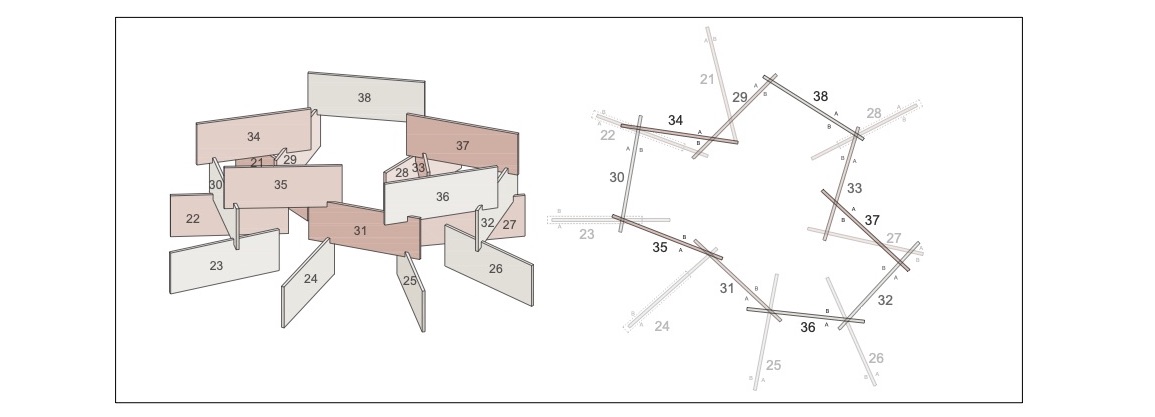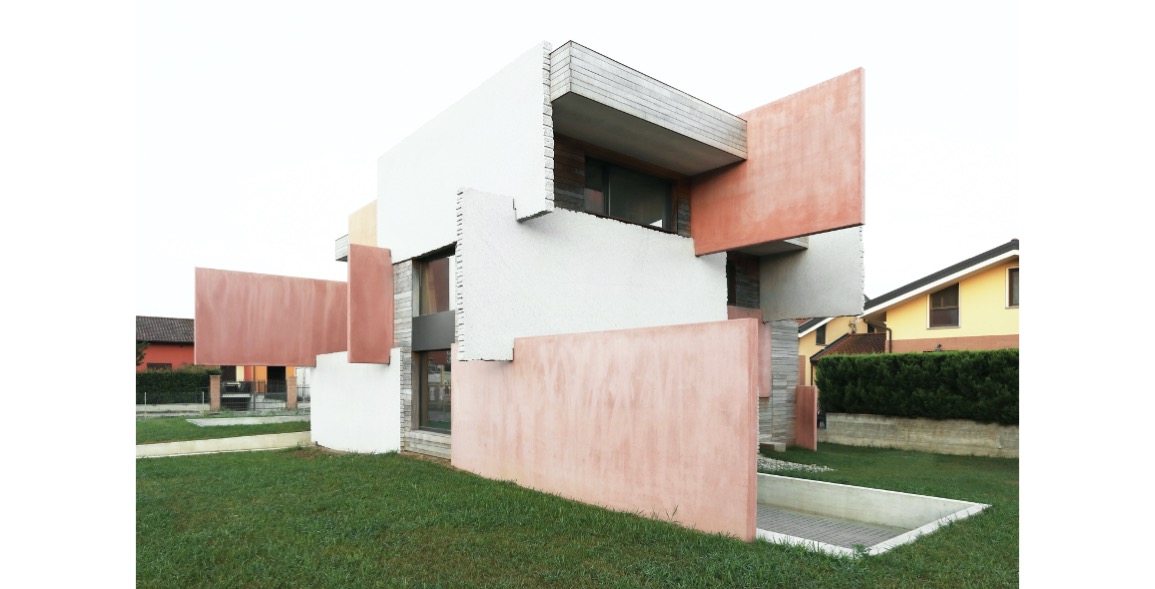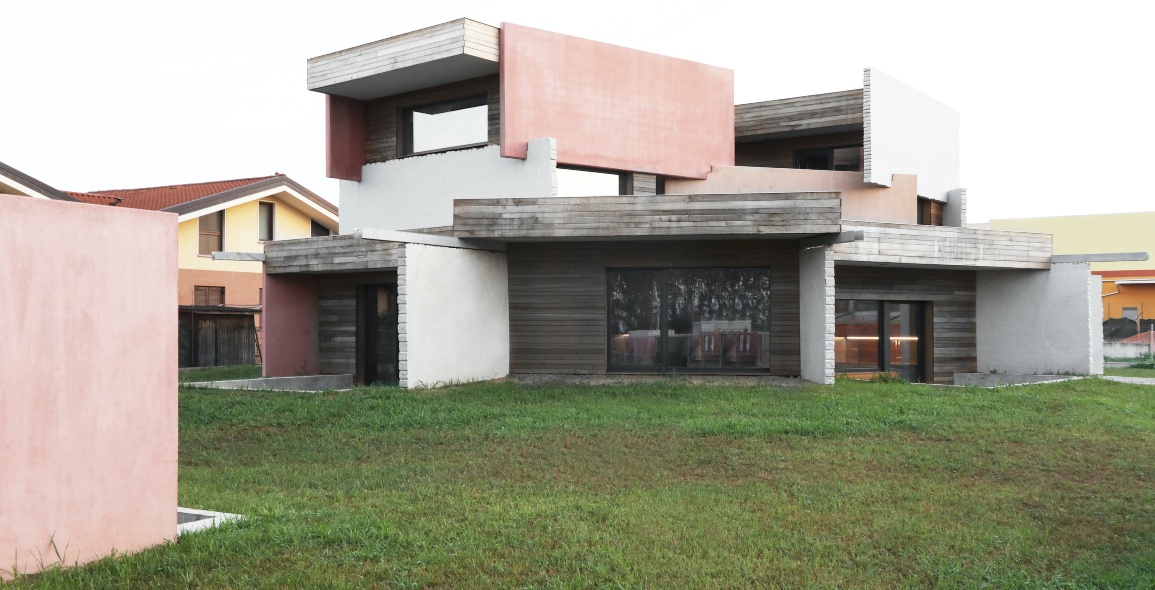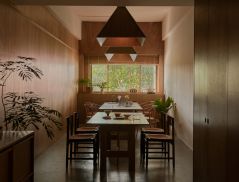
Houses of Cards have been built through a long process of research, design and experimentation on materials, technology and program. The binding element of this process was the courage and trust of the client who accepted to be part of a journey of which these two buildings are only a fragment.
Research
The project for Houses of Cards started long before it was actually commissioned at the end of 2015. Elastico Farm has been carrying on for years a structured research on building materials and on the technology and techniques related to them. In the last 10 years, we have been engaged in the study and experimental application of prefabricated structural elements for industrial buildings. At the same time we have worked with the brick, stone, wood and prefabricated reinforced concrete industries to fully understand their potential and the possibilities for alternative or/and combined use of those materials in the construction market. Our research on Sardinian granite began in 2013 when we were approached by a quarry from Olbia to study their material and to evaluate the unexpressed potential of this unique, relatively inexpensive and abundant product.


Design
Houses of Cards, built in an allotment of a small town in the province of Turin, in Northern Italy, are part of the experimentation phase on the large granite slab for use as a load-bearing construction element. Both houses consist of a triple level of superimposed septa that connect thanks to a system of cuts and metal dowels. During the structural design phase, for normative reasons related to their certification, we chose to combine granite slabs with other concrete panels. This allowed us to study the material without having to go through a lengthy certification process, which would have delayed and perhaps compromised the possibility of completing the project. Working in combination with the coloured concrete panels has helped us to understand the limits and opportunities of this material. This is now helping us to develop the research and carry on the experimentation on pre-cast concrete through some other projects we have now underway.
Research and experimentation on the material has therefore developed in hand-in-hand with that on the structural system based on load-bearing panels. The shape of the two houses comes from a sequential approach to the project. Starting from a regular and intuitive scheme – the Cat House – we developed a second project – the Dog House – in which the theoretical problems identified in the structure of the first building are solved by form. This produced more complex spaces.
The Cat House has an orthogonal structure, which determines its weakness in reacting to forces produced by an hypothetical earthquake; the dry mounted panels therefore needs metal bracings and reinforcements to resist transverse forces. The Dog House, instead, thanks to its shape developed around a central courtyard, does not require additional bracings. The complexity of its radial form produces a structurally efficient building.
The research carried out during the design phase was tested in the construction site: this was the phase of experimentation and verification, this was when it was possible to identify new problems, solve them and process them in order to understand if the idea behind the project can become a possible construction system.


Materials
Sardinian granite is an intrusive igneous rock that has excellent properties due to the pressure and temperatures at the origin of its formation. While in the past it was widely used for structural purposes (as for the columns of the Pantheon), nowadays it is normally employed for cladding or for flooring. The consistency of Sardinian granite, together with its homogeneity and resistance, makes it ideal for paving large surfaces such as airports, [train] stations and public places subject to traffic and wear. In these years, the rapid evolution of ceramic materials and the possibility of finding highly performing stone products at very competitive prices from East Asia are slowly eroding the market share once held by this product of our territory.
The investigation into the properties of the material and the quarrying methods suggested the possibility of working with large monolithic elements that could be produced directly on the excavation site. The idea of using granite for the load-bearing panels came from the observation of the excavation process and the acquired knowledge of the technologies with which the rock is extracted and trimmed. To be more specific, the cutting of the quarry wall with the wires allows a certain accuracy, while the compactness of the material makes it possible to produce blocks and slabs even of very large dimensions. Considering the weights and overall dimensions for transporting the slabs (by land and sea), we established that a plausible size for an optimal use of the panel was 600 cm by 240 cm, with a variable thickness depending on the structural needs from 12 cm to 20 cm. In principle, the resistance to compression and flexure of a granite panel is comparable to that of reinforced concrete panels of similar thickness.
Program
All the structural investigations and the subsequent formal choices had to deal with the program and the specific requirements of the single-family house typology, as well as with the needs of those who now live there. The houses, belonging to two sisters, have similar dimensions, but are very different in their distribution and inner spatial relationships.
The Cat House has an orthogonal and very compact structure, in which the slabs define a sequence of external micro-environments that filter the passage towards the inside of the house. There, a double height hall connects the different levels. The heart of the house therefore acts as a scenographic distribution element and can be perceived from every room.
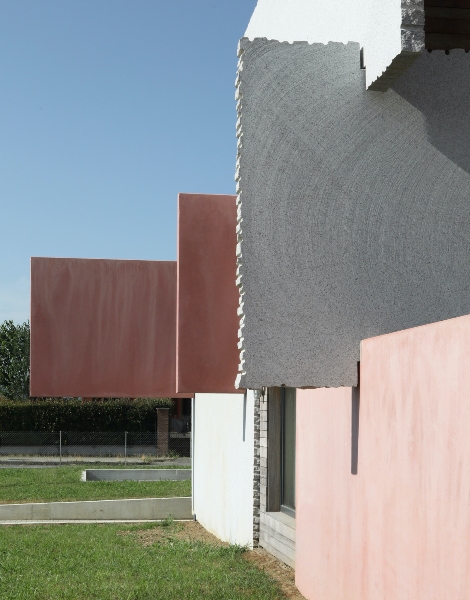

The structure of the Dog House develops around a central patio, an empty core that serves as an inner courtyard, whose access is mediated by a sequence of spaces defined by the radial arrangement of the slabs. Even the internal rooms, on the ground floor, are arranged radially and always have direct contact with both the garden and the inner courtyard. On the first floor, on the other hand, the irregular layout of the structural panels produces less predictable internal and external spaces. Both bedrooms open onto a large terrace overlooking the empty interior of the house, an intimate space, closed to the outside and the nearby street.
In both buildings, the load-bearing structure plays a scenographic role and defines the essence of the two houses. The slabs, with the materiality of granite or with the colour of the concrete, define and give character to the spaces. In the Cat House the regular arrangement of the panels conveys rigour and produces a sense of closure and finiteness of the space; the structural elements appear as fragments inside the rooms, as formal accents capable of playing with light and colour. In the Dog House, on the other hand, the radial structure of the first level contrasts with the necessary irregularity in their arrangement on the other two levels, hinting at an unfinished system and spaces that can change and evolve. If the granite and concrete structural elements convey a sense of permanence, the wooden partitions let one perceive the possibility that time will lead to their transformation and potential dissolution.


Experimenting
The experimentation for Houses of Cards began in the quarry and in the factory where the prefabricated concrete panels were produced. Together with the companies involved in the supply of the materials, Elastico Farm has developed a great deal of preliminary work on production. During this part of the process, alternatives were examined and the tolerances required for construction were materially assessed.
This preliminary work made it possible to produce numbered panels that could be assembled on site without unforeseen complications. For the Cat House the assembly work of the drywall panels had to be coordinated with that of the metal structures, increasing the degree of difficulty and the need for precision in production. The construction system proved to be very efficient and fast, even though it required great precision and therefore a highly qualified crew. The coloured concrete panels actually proved to be more fragile at the corners than the stone ones and therefore needed more attention during assembly. Concrete panels, on the other hand, could be produced faster and with greater precision, therefore they needed a smaller tolerance. These purely technical observations influenced some choices related to the finishes.
Houses of Cards were produced through an open process, which was able to be elastically adapted to the unpredictability of the construction site. Similarly to the vertical structures, the floors were installed using the technology of the composite slab in concrete and steel. These elements rest directly on the panels thanks to saddle or plate connections and connect the structural slabs together. During the design phase we paid great attention to the choice of the more efficient technologies to insulate and waterproof the structural skeleton and the entire building. During the construction and testing phase, the project decisions were sometimes revised and modified, so that they could be considered reliable even in the
long term. The different points of contact between the structural elements and those between them and the building envelope have required solutions that were always very specific. This allowed us to solve every thermal bridge and avoid possible infiltrations while always keeping clear.
During the design and the construction phase, we managed to develop a strategy capable of avoiding thermal bridges even when the slabs are exhibited in the interior. In both houses, cast-on-pace concrete was used only for the foundations and the composite slabs. All the finishes both inside and outside are consistent with the initial concept. Mechanical and electrical systems rely on solutions that allow great flexibility for possible future changes and expansions.
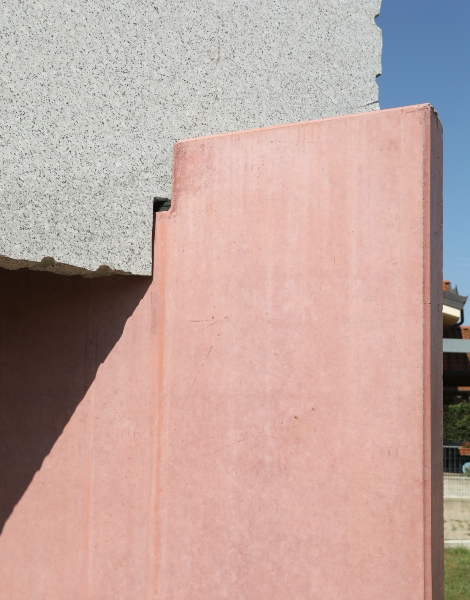

Conclusion
Houses of Cards are the outcome of a long design and of an elaborate construction process, a project that is part of a wider discourse but capable of living independently. The single-family house allows a certain degree of flexibility that is not possible in other building typologies and for this reason it has always been a testing ground for architecture. In this case the results, properly adapted and engineered, have become part of more complex projects for buildings of different scales already under construction today.
In deliberate contrast with a meaningless and very poorly built context, these houses, produced by the assembly of stone and cement slabs and identified by that combination of colours and materials, seem to have materialised by chance and by chance seem to have been occupied. With its unequivocal hierarchy of loadbearing structure and carried structure, of durable and perishable matter, it collects the successes and failures of each experiment, suggesting a series of possible future trajectories.
In Houses of Cards, the structure, the material and the construction technique contribute to the search for a space capable of surprising the designer first and then the visitor. It is an organic space in which every detail is a natural product of that constructive logic already present in the initial concept. Here, as in many other buildings by Elastico Farm, the project obsessively plans the actions but cannot and does not want to predict the final result because the main value of the experiment does not lie in the realisation of the initial idea, but in the discovery of the consequences that this implies. A discovery that cannot ignore the “concretisation” of the idea itself, since only when a project acquires a material dimension it begins to behave in an unpredictable way.
Houses of Cards are two autonomous entities occupied by two families who have adapted them to their modus vivendi. They reflect the expectations of the client who interpreted them and manages them freely without feeling influenced by issues related to the architect’s aesthetic choices. They are two small buildings produced by an almost primitive reasoning that, thanks to technology and new construction techniques, are able to provide spaces for today’s life.


 Share
Share
